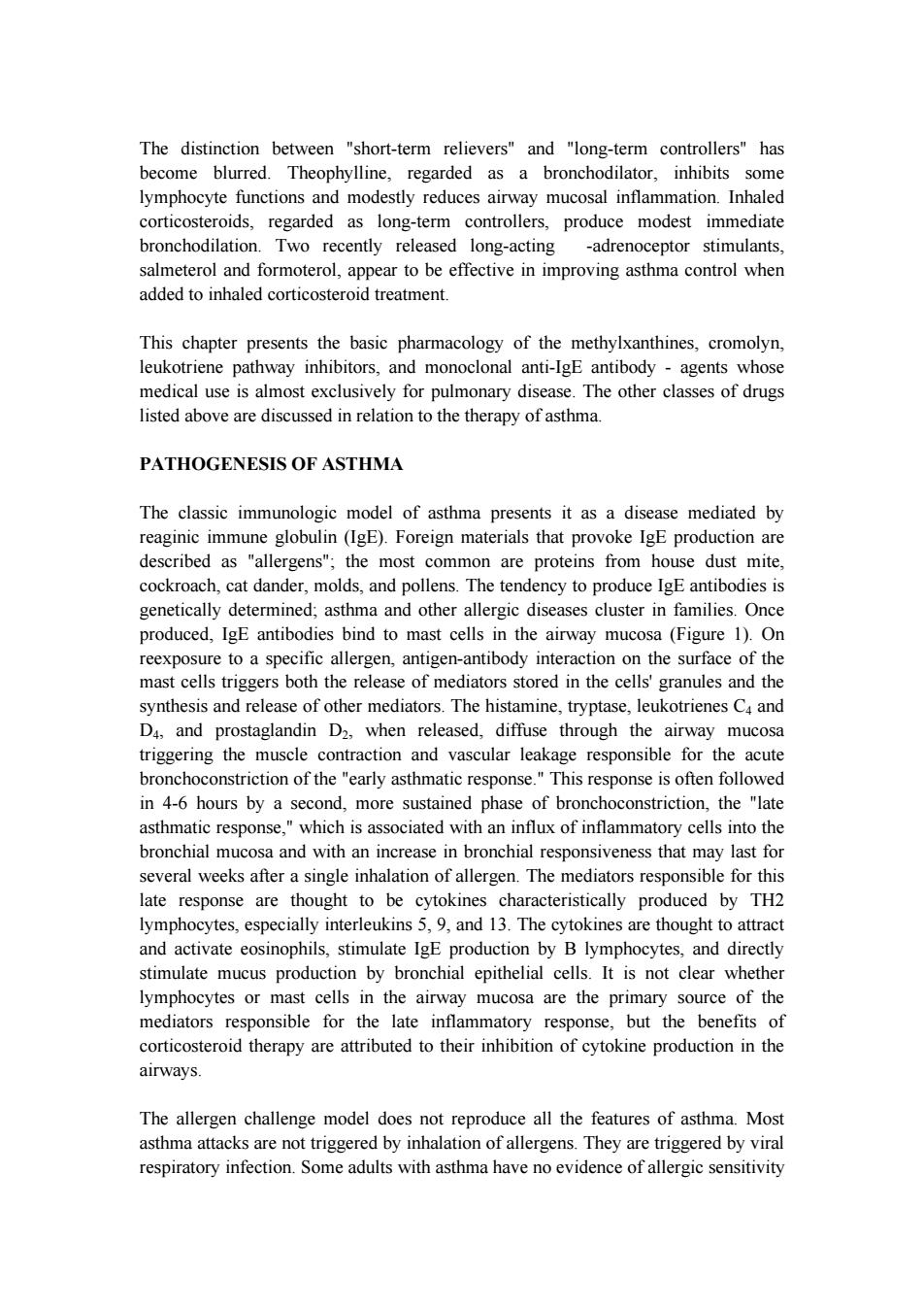正在加载图片...

The distinction between "short-term relievers"and "long-term controllers"has become blurred.Theophylline,regarded as a bronchodilator,inhibits some lymphocyte functions and modestly reduces airway mucosal inflammation.Inhaled corticosteroids,regarded as long-term controllers,produce modest immediate bronchodilation.Two recently released long-acting -adrenoceptor stimulants, salmeterol and formoterol,appear to be effective in improving asthma control when added to inhaled corticosteroid treatment. This chapter presents the basic pharmacology of the methylxanthines,cromolyn, leukotriene pathway inhibitors,and monoclonal anti-IgE antibody -agents whose medical use is almost exclusively for pulmonary disease.The other classes of drugs listed above are discussed in relation to the therapy of asthma. PATHOGENESIS OF ASTHMA The classic immunologic model of asthma presents it as a disease mediated by reaginic immune globulin (IgE).Foreign materials that provoke IgE production are described as "allergens";the most common are proteins from house dust mite, cockroach,cat dander,molds,and pollens.The tendency to produce IgE antibodies is genetically determined;asthma and other allergic diseases cluster in families.Once produced,IgE antibodies bind to mast cells in the airway mucosa (Figure 1).On reexposure to a specific allergen,antigen-antibody interaction on the surface of the mast cells triggers both the release of mediators stored in the cells'granules and the synthesis and release of other mediators.The histamine,tryptase,leukotrienes C4 and D4,and prostaglandin D2,when released,diffuse through the airway mucosa triggering the muscle contraction and vascular leakage responsible for the acute bronchoconstriction of the "early asthmatic response."This response is often followed in 4-6 hours by a second,more sustained phase of bronchoconstriction,the "late asthmatic response,"which is associated with an influx of inflammatory cells into the bronchial mucosa and with an increase in bronchial responsiveness that may last for several weeks after a single inhalation of allergen.The mediators responsible for this late response are thought to be cytokines characteristically produced by TH2 lymphocytes,especially interleukins 5,9,and 13.The cytokines are thought to attract and activate eosinophils,stimulate IgE production by B lymphocytes,and directly stimulate mucus production by bronchial epithelial cells.It is not clear whether lymphocytes or mast cells in the airway mucosa are the primary source of the mediators responsible for the late inflammatory response,but the benefits of corticosteroid therapy are attributed to their inhibition of cytokine production in the airways The allergen challenge model does not reproduce all the features of asthma.Most asthma attacks are not triggered by inhalation of allergens.They are triggered by viral respiratory infection.Some adults with asthma have no evidence of allergic sensitivityThe distinction between "short-term relievers" and "long-term controllers" has become blurred. Theophylline, regarded as a bronchodilator, inhibits some lymphocyte functions and modestly reduces airway mucosal inflammation. Inhaled corticosteroids, regarded as long-term controllers, produce modest immediate bronchodilation. Two recently released long-acting -adrenoceptor stimulants, salmeterol and formoterol, appear to be effective in improving asthma control when added to inhaled corticosteroid treatment. This chapter presents the basic pharmacology of the methylxanthines, cromolyn, leukotriene pathway inhibitors, and monoclonal anti-IgE antibody - agents whose medical use is almost exclusively for pulmonary disease. The other classes of drugs listed above are discussed in relation to the therapy of asthma. PATHOGENESIS OF ASTHMA The classic immunologic model of asthma presents it as a disease mediated by reaginic immune globulin (IgE). Foreign materials that provoke IgE production are described as "allergens"; the most common are proteins from house dust mite, cockroach, cat dander, molds, and pollens. The tendency to produce IgE antibodies is genetically determined; asthma and other allergic diseases cluster in families. Once produced, IgE antibodies bind to mast cells in the airway mucosa (Figure 1). On reexposure to a specific allergen, antigen-antibody interaction on the surface of the mast cells triggers both the release of mediators stored in the cells' granules and the synthesis and release of other mediators. The histamine, tryptase, leukotrienes C4 and D4, and prostaglandin D2, when released, diffuse through the airway mucosa triggering the muscle contraction and vascular leakage responsible for the acute bronchoconstriction of the "early asthmatic response." This response is often followed in 4-6 hours by a second, more sustained phase of bronchoconstriction, the "late asthmatic response," which is associated with an influx of inflammatory cells into the bronchial mucosa and with an increase in bronchial responsiveness that may last for several weeks after a single inhalation of allergen. The mediators responsible for this late response are thought to be cytokines characteristically produced by TH2 lymphocytes, especially interleukins 5, 9, and 13. The cytokines are thought to attract and activate eosinophils, stimulate IgE production by B lymphocytes, and directly stimulate mucus production by bronchial epithelial cells. It is not clear whether lymphocytes or mast cells in the airway mucosa are the primary source of the mediators responsible for the late inflammatory response, but the benefits of corticosteroid therapy are attributed to their inhibition of cytokine production in the airways. The allergen challenge model does not reproduce all the features of asthma. Most asthma attacks are not triggered by inhalation of allergens. They are triggered by viral respiratory infection. Some adults with asthma have no evidence of allergic sensitivity